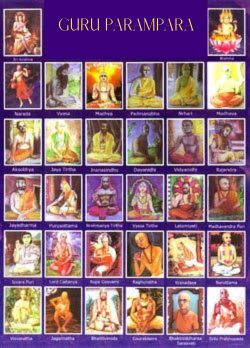
The Disciplic Succession
Padma Purana
sampradāya-vihīn ye mantrās te
niṣphalā matāḥ sampradāya-vihīna
—without being connected with a bona fide sampradāya, or disciplic succession; ye—which; mantraḥ—mantras; te—those; niṣphalāḥ—fruitless; matāḥ—are considered. If one is not actually connected with a bona fide disciplic succession, whatever mantras he chants will not bring the desired result.
Undoubtedly, a question arises in the minds of readers as to why should we receive knowledge from a Spiritual Master in Disciplic Succession?
Here’s the answer: The path of spiritual realization is undoubtedly difficult. The Lord therefore advises us to approach a bona fide spiritual master in the line of disciplic succession from the Lord Himself. No one can be a bona fide spiritual master without following this principle of disciplic succession. The Lord is the original spiritual master,

and a person in the disciplic succession can convey the message of the Lord as it is to his disciple.
(Bhagavad Gīta 4.34 Purport)
Lord Krsna himself affirms in Bhagavad Gīta 4.2 : “Evam parampara-praptam imam rajarsayo viduh”, This Supreme science was thus received through the chain of Disciplic Succession, and the Saintly Kings understood it in this way”.
Receiving Knowledge through disciplic succession is so important that Srila Prabhupada, gave the list of complete disciplic succession of the Brahma-Madhva-Gaudiya Sampradaya right away in the Introduction to Bhagavad Gīta As It Is.
1.Krisna
2.Brahma
3.Narada
4.Vyasa
5.Madhva
6.Padmanabha
7.Nrhari
8.Madhava
9.Aksobhya
10.Jaya Tirtha
11.Jnanasindhu
12.Dayanidhi
13.Vidyanidhi
14.Rajendra
15.Jayadharma
16.Purusottama
17.Brahmanya Tirth
18.Vyasa Tirtha
19.Laksmipati
20.Madhavendra Puri
21.Isvara Puri, (Nityananda, Advaita)
22.Lord Caitanya
23.Rupa, (Svarupa, Sanatana)
24.Raghunatha, Jiva
25.Krsnadasa
26.Narottama
27.Visvanatha
28.(Baladeva) Jagannatha
29.Bhaktivinoda
30.Gaurakisora
31.Bhaktisiddhanta Sarasvati
32.HDG A.C. Bhaktivedanta Swami Srila Prabhupada
The name of our sampradaya — Brahma-Madhva-Gaudiya-sampradaya – suggests three distinct phases, or links in the disciplic chain. The disciplic succession begins with Lord Brahma, who first received it in his heart directly from Lord Krsna and then instructed his disciple Narada. Narada Muni in turn enlightened Srila Vyasa Dev and the second phase is marked after Vyasadev with Sripada Madhvacarya. He took his birth at Udupi in the year of A.D. 1119 and from his base in Udupi, he went on to establish what continues
today as a strict system of succession. Although between Vyasadeva and Madhva there is a big gap. But it is sometimes said that Vyasadeva is still living, and Madhva was fortunate enough to meet him directly.
The third phase of the succession is marked by the appearance of Lord Caitanya in Gauda-desa, Bengal. Lord Caitanya took birth in Navadvipa, Bengal in the year A.D. 1407.

Lord Caitanya did not formally initiate anyone, and it is stated by Sanatana Goswami that, as an incarnation, he would not personally do so.
Prior to Lord Caitanya’s appearance Madhavendra Puri appeared, and he initiated several of Caitanya’s associates, including Sri Advaita Acharya and Sri Nityananda prabhu. Madhavendra Puri also initiated Lord Caitanya’s own guru, Isvara Puri. As stated in Caitanya-caritamrta, Madhya lila 4:197, Sri Madhavendra Puri introduced the conception of conjugal love for the first time in the Madhvacharya-sampradaya, and this conclusion was later revealed by Sri Caitanya Mahaprabhu.
Later, in the disciplic chain of Lord Caitanya, came many Acharyas and the most recent five Acharyas are Srila Jagannath Das Babaji Maharaj, Srila Bhaktivinode Thakur, Srila Gaurakishore Das Babaji Maharaj, Srila Bhaktisiddhanta Saraswati Thakur who became the spiritual master of A.C. Bhaktivedanta Swami Prabhupada, the most recent Sampradaya Acarya, who appeared in 1896 in Calcutta.

Bhaktivinode Thakur vehemently protested against the principles of the then pseudo-transcendentalists who passed in the name of Lord Chaitanya. He initiated the reformatory movement by literary contributions while he still engaged as a high Government Officer. During his householder life and serving as a Magistrate, he wrote books of various descriptions in Bengali, English, Sanskrit & etc. to present an actual picture of pure devotional activities to Lord Chaitanya.
Srila Bhakti Siddhanta Saraswati Goswami Maharaj got inspiration from his very Childhood all about Sreela Thakur Bhaktivinode’s movement. The founder of Gaudiya Math and also known as Simha Guru, he took up reins of the reformatory movement after Srilla Bhaktivinode Thakur’s departure,
Apart from our Sampradaya, there are 3 more Sampradayas, viz., Sri Sampradaya, Rudra Sampradaya and Kumara Sampradaya.
In Sri Sampradaya, the prominent Acharya Sri Ramanujacharya wrote The commentary known as Śrī-bhāṣya which establishes the viśiṣṭādvaita-vāda philosophy. Similarly, in the Brahma-sampradāya, Madhvācārya’s Pūrṇaprajña-bhāṣya establishes śuddha-dvaita-vāda. In the Kumāra-sampradāya, or Nimbārka-sampradāya, Śrī Nimbārka establishes the philosophy of dvaitādvaita-vāda in the Pārijāta-saurabha-bhāṣya. And in the Viṣṇu-svāmi-sampradāya, or Rudra-sampradāya, which comes from Lord Śiva, Viṣṇu Svāmī has written a commentary called Sarvajñabhāṣya, which establishes śuddhādvaita-vāda.
(Purport CC Antya 2.95)
Śrī-bhāṣya

Srila Prabhupada often quotes the word: Ācāryopāsanam which means one should worship an ācārya, a spiritual master who knows things as they are. The spiritual master must be in the disciplic succession from Kṛṣṇa.
The importance of Spiritual master is also explained in Śrimad Bhāgavatm:
tasmād guruṁ prapadyeta
jijṣāsuḥ śreya uttamam
śābde pare ca niṣṇātaṁ
brahmaṇy upaśamāśrayam
Therefore any person who seriously desires real happiness must seek a bona fide spiritual master and take shelter of him by initiation. The qualification of the bona fide guru is that he has realized the conclusions of the scriptures by deliberation and is able to convince others of these conclusions. Such great personalities, who have taken shelter of the Supreme Godhead, leaving aside all material considerations, should be understood to be bona fide spiritual masters.
Material Knowledge needs teachers, experts, philosophers, to explain how things work, will not the Spiritual Science which is an Ocean, need a Spiritual Master???
